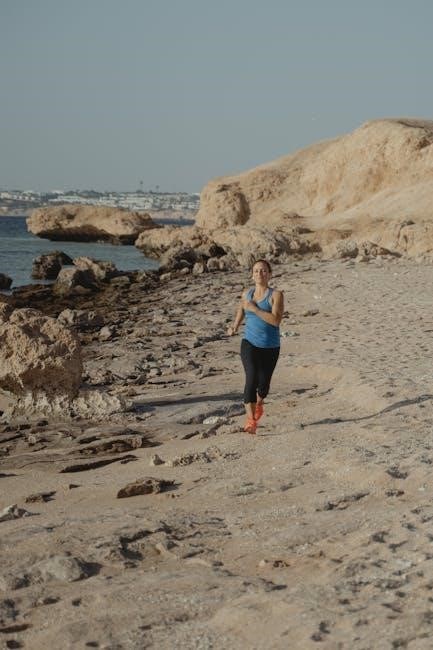Building a Non-Anxious Life⁚ A Comprehensive Guide
This guide explores practical strategies for cultivating a calmer, more resilient life. Discover evidence-based techniques from CBT and mindfulness to address anxiety’s root causes and build lasting emotional well-being. Learn six daily choices for a less anxious existence, empowering you to take control of your anxieties and create a more peaceful future.
Understanding Anxiety’s Root Causes
Anxiety, a pervasive modern ailment, often stems from a complex interplay of factors. While genetics can predispose individuals to heightened anxiety, environmental influences play a crucial role. Trauma, both past and present, significantly contributes, leaving lasting emotional scars that manifest as anxiety. Similarly, stressful life events, such as job loss, relationship difficulties, or financial strain, can trigger or exacerbate anxiety symptoms. Furthermore, underlying health conditions, including thyroid problems or vitamin deficiencies, can sometimes contribute to anxiety. Negative thought patterns and cognitive distortions, such as catastrophizing or overgeneralization, fuel anxiety’s cycle. Social isolation and lack of meaningful connections can also amplify feelings of anxiety and vulnerability. Understanding these diverse root causes is crucial for developing a tailored approach to managing and mitigating anxiety, paving the way for a more peaceful and fulfilling life.
The Six Daily Choices for a Non-Anxious Life
Dr. John Delony’s framework emphasizes six crucial daily choices for cultivating a non-anxious life. “Choosing Reality” involves confronting fears and accepting life’s uncertainties without succumbing to anxiety. “Choosing Connection” focuses on building and nurturing meaningful relationships, fostering a sense of belonging and support. “Choosing Freedom” entails identifying and challenging limiting beliefs that fuel anxiety, replacing them with empowering perspectives. “Choosing Health and Healing” prioritizes physical and mental well-being through healthy habits, adequate sleep, and stress management techniques. “Choosing Mindfulness” cultivates present moment awareness, reducing overthinking and future anxieties. Finally, “Choosing Belief” involves nurturing a positive mindset, focusing on gratitude and cultivating inner peace. These interwoven choices, practiced consistently, create a powerful foundation for a less anxious existence, fostering resilience and emotional well-being. The emphasis lies on proactive engagement and self-empowerment, replacing reactive anxiety with intentional action.
Choosing Reality⁚ Confronting Your Fears
This crucial step in building a non-anxious life involves directly addressing anxieties rather than avoiding them. It’s about acknowledging and accepting uncomfortable emotions without judgment. Instead of fearing the future or dwelling on past mistakes, the focus shifts to the present moment. This doesn’t mean ignoring problems; instead, it’s about facing them head-on with a realistic assessment. Techniques like journaling can help process emotions, while cognitive restructuring helps challenge negative thought patterns that amplify anxiety. Mindfulness practices further enhance this process by anchoring you in the present, reducing the power of anxious thoughts about the future or regrets about the past. By honestly evaluating situations and accepting what is, rather than what you wish were, you gradually lessen anxiety’s hold, replacing fear with a sense of groundedness and control. This approach fosters self-awareness and resilience, enabling you to navigate challenges with greater calm and clarity.
Choosing Connection⁚ Building Meaningful Relationships
Strong, supportive relationships are vital for a non-anxious life. Human connection combats feelings of isolation and loneliness, common anxiety triggers. Nurturing these bonds requires conscious effort⁚ prioritize quality time with loved ones, engage in active listening, and express appreciation openly. Cultivate empathy and understanding, fostering a sense of belonging and mutual support. Don’t be afraid to seek help from trusted individuals when facing challenges; sharing burdens lightens the load and strengthens connections. Building a network of supportive friends and family provides a safety net during stressful periods, reducing feelings of vulnerability. Remember that healthy relationships are reciprocal; invest time and energy in nurturing them, reaping the emotional rewards of a strong social support system. This reduces the feeling of isolation and strengthens your ability to cope with life’s stressors, building resilience and reducing overall anxiety levels.
Choosing Freedom⁚ Breaking Free from Limiting Beliefs
Anxiety often stems from rigid, negative thought patterns. Challenge these limiting beliefs by questioning their validity. Are they based on facts or assumptions? Identify cognitive distortions like catastrophizing or all-or-nothing thinking. Replace negative self-talk with positive affirmations and realistic self-assessments. Practice self-compassion; treat yourself with the same kindness and understanding you’d offer a friend. Embrace imperfection; accept that setbacks are part of life and don’t define your worth. Cultivate a growth mindset, viewing challenges as opportunities for learning and growth rather than threats. Remember that your thoughts don’t dictate your reality; you have the power to reshape them. By consciously challenging and reframing negative beliefs, you create space for more positive, empowering thoughts, freeing yourself from the constraints of anxiety-inducing self-doubt and fostering a sense of personal agency and control.
Choosing Health and Healing⁚ Prioritizing Physical and Mental Well-being
Prioritizing physical health is paramount in building a non-anxious life. Regular exercise significantly reduces stress and improves mood. Aim for at least 30 minutes of moderate-intensity exercise most days of the week. Nourish your body with a balanced diet rich in fruits, vegetables, and whole grains. Limit processed foods, sugar, and caffeine, as these can exacerbate anxiety symptoms. Prioritize sufficient sleep; aim for 7-9 hours of quality sleep each night to allow your body and mind to rest and repair. Engage in relaxation techniques such as deep breathing exercises, progressive muscle relaxation, or yoga to calm your nervous system. Stay hydrated by drinking plenty of water throughout the day. Consider incorporating mindfulness practices into your daily routine to cultivate present moment awareness and reduce overthinking. Remember that physical and mental well-being are interconnected; nurturing one supports the other, leading to a more balanced and resilient state.
Choosing Mindfulness⁚ Cultivating Present Moment Awareness
Mindfulness, the practice of focusing on the present moment without judgment, is a powerful tool for anxiety reduction. By cultivating present moment awareness, you gently redirect your attention away from worries about the future or regrets about the past. Simple mindfulness exercises, such as focusing on your breath or body sensations, can ground you in the present, calming racing thoughts. Mindful activities like mindful walking or eating engage your senses, increasing your awareness of the here and now. Regular mindfulness meditation, even for just a few minutes each day, can significantly improve your ability to manage anxiety and stress. The key is to approach mindfulness practices with patience and self-compassion, understanding that your mind will wander. When this happens, simply acknowledge the wandering thought without judgment and gently redirect your attention back to your chosen focus. Consistent practice fosters a greater sense of calm and reduces reactivity to anxious thoughts and feelings, creating a more peaceful inner landscape.
Choosing Belief⁚ Fostering a Positive Mindset
Cultivating a positive mindset is crucial in building a non-anxious life. This doesn’t mean ignoring negative emotions or pretending everything is perfect; rather, it involves consciously choosing to focus on what you can control and fostering a sense of hope and optimism. Challenge negative thought patterns by asking yourself if they are truly accurate and helpful. Replace self-critical thoughts with self-compassionate ones. Practice gratitude by regularly acknowledging the good things in your life, no matter how small. Surround yourself with positive influences—people, books, and activities that uplift and inspire you. Develop a strong sense of self-worth, recognizing your inherent value and capabilities. Believe in your ability to overcome challenges and persevere through difficult times. Remember that setbacks are temporary and learning opportunities, not evidence of personal failure. Affirmations, positive self-talk, and visualization techniques can also reinforce positive beliefs and build resilience against anxiety. By consciously choosing to foster a positive mindset, you create a foundation for greater emotional stability and resilience.
Practical Strategies and Techniques
Beyond the foundational principles, practical strategies are vital for managing anxiety. Prioritize sufficient sleep; aim for 7-9 hours of quality rest nightly to improve mood regulation and reduce stress. Regular exercise is crucial; physical activity releases endorphins, natural mood boosters that combat anxiety. Mindful movement practices like yoga or tai chi can be particularly beneficial, combining physical activity with a focus on the present moment. Healthy eating habits are essential; nourish your body with whole, unprocessed foods to support both physical and mental health. Limit caffeine and alcohol intake, as these substances can exacerbate anxiety symptoms. Engage in relaxation techniques such as deep breathing exercises, progressive muscle relaxation, or guided imagery to calm your nervous system. Create a calming environment at home, incorporating elements that promote peace and tranquility. Establish a daily routine to provide structure and reduce uncertainty, decreasing anxiety triggers. Learn to say no to commitments that overextend you, protecting your time and energy. Prioritize self-care activities that bring you joy and relaxation, allowing time for hobbies and activities you genuinely enjoy. Remember that building a non-anxious life is a journey, not a destination, requiring consistent effort and self-compassion.
Cognitive Behavioral Therapy (CBT) Techniques
Cognitive Behavioral Therapy (CBT) offers powerful tools for managing anxiety. A core CBT technique is cognitive restructuring, identifying and challenging negative or distorted thought patterns contributing to anxiety. This involves replacing unhelpful thoughts with more balanced and realistic perspectives. For example, if you anticipate a catastrophic outcome, CBT helps you examine the evidence supporting that fear and develop alternative, more adaptive interpretations. Exposure therapy is another key CBT method, gradually exposing yourself to feared situations or objects in a safe and controlled manner. This helps to reduce avoidance behaviors and desensitize you to anxiety triggers. Behavioral experiments involve testing out your negative beliefs in real-life situations. By gathering evidence that contradicts these beliefs, you can challenge their validity and reduce their power over you. Alongside these core techniques, CBT incorporates relaxation and stress management skills, such as deep breathing exercises and mindfulness practices, to equip you with coping strategies for managing anxious feelings in the moment. Remember, consistent practice is crucial for success with CBT techniques, and seeking guidance from a qualified therapist can significantly enhance your progress.
Mindfulness Practices for Anxiety Reduction
Mindfulness, the practice of focusing on the present moment without judgment, offers a powerful antidote to anxiety. Techniques like mindful breathing involve paying close attention to the sensation of each breath, anchoring you in the present and reducing mind-wandering. Mindful body scans systematically bring awareness to different parts of your body, noticing sensations without trying to change them. This helps to ground you and reduce feelings of overwhelm. Mindful walking involves paying attention to the physical sensations of walking – the feeling of your feet on the ground, the movement of your body – shifting your focus away from anxious thoughts. Meditation, a cornerstone of mindfulness practice, cultivates a state of focused attention and awareness, reducing reactivity to stressful thoughts and emotions. Progressive muscle relaxation involves tensing and releasing different muscle groups, promoting physical relaxation and reducing the body’s physical tension often associated with anxiety. Regular practice of these techniques strengthens your ability to observe your thoughts and feelings without getting carried away by them, fostering a sense of calm and emotional regulation.
Seeking Professional Support
While self-help strategies are valuable, seeking professional support is crucial for managing persistent or severe anxiety. A therapist can provide personalized guidance, tailoring interventions to your specific needs and challenges. Cognitive Behavioral Therapy (CBT) is an evidence-based approach that helps identify and modify negative thought patterns and behaviors contributing to anxiety. Exposure therapy, a type of CBT, gradually exposes you to feared situations or objects in a safe and controlled environment, helping to reduce avoidance and fear responses. Medication, in some cases, can be a helpful adjunct to therapy, particularly for managing severe anxiety symptoms. Psychiatrists can assess your needs and prescribe appropriate medication, often in conjunction with therapy. Support groups offer a sense of community and shared experience, allowing you to connect with others facing similar challenges. Remember, seeking help is a sign of strength, not weakness. Professional guidance can provide the tools and support needed to navigate your anxiety journey effectively and build a more fulfilling life.



